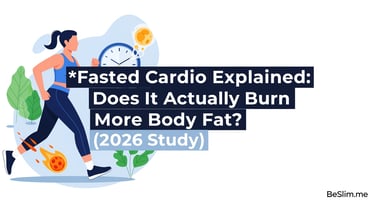Hey there, fitness warriors! I'm Master Kim, your Certified Personal Trainer (CPT) and Biomechanics Specialist at BeSlim.me. If you've ever heard the buzz about the "afterburn effect" – that magical post-workout calorie torching that supposedly keeps your metabolism revved up for hours – you're not alone. It's been hyped as a fat-loss shortcut, but is it all it's cracked up to be? In this guide, we'll dive into the latest 2026 research on Excess Post-Exercise Oxygen Consumption (EPOC), debunk some myths, and arm you with a safe, science-backed workout to harness its real benefits. Whether you're a beginner easing into fitness or someone with joint concerns, I'll keep things practical, motivational, and above all, safe. Let's crush those fat-loss goals without the hype!
EPOC, often called the afterburn effect, refers to the increased oxygen your body needs after intense exercise to restore itself – think replenishing energy stores, repairing tissues, and balancing hormones. While it's not the fat-melting miracle some claim, it does contribute to overall calorie burn and metabolic health. We'll explore the science, then I'll share a beginner-friendly 30-minute routine to get you started. Remember, consistency beats intensity every time – let's build sustainable habits!
The Science Behind EPOC Afterburn Effect and Metabolism
Let's get geeky for a moment – but in a fun, accessible way! EPOC is your body's way of recovering from exercise stress. When you work out, especially with high-intensity efforts, your metabolism doesn't just snap back to normal. Instead, it stays elevated as your system works overtime to cool down, remove lactic acid, and rebuild muscle fibers. This "afterburn" can last from a few minutes to several hours, depending on the workout's intensity and duration.
Physiologically, EPOC boosts fat loss by increasing your basal metabolic rate (BMR) temporarily. Here's why: During recovery, your body taps into fat stores for energy more efficiently, thanks to heightened hormone activity like epinephrine and growth hormone. Resistance training, for instance, creates micro-tears in muscles, which your body repairs using calories – often from fat. A 2026 study highlights how this process enhances insulin sensitivity, making your body better at using carbs and fats for fuel, which supports long-term weight management.
But is the afterburn effect overhyped? Absolutely, for most people. Popular myths suggest you can burn hundreds of extra calories lounging on the couch post-workout, but research shows EPOC typically accounts for only 6-15% of total workout calories burned. For a 30-minute session, that might mean just 20-50 extra calories – helpful, but not a game-changer without consistent effort. The real magic? Building muscle through EPOC-inducing workouts raises your overall BMR, so you burn more calories at rest over time. According to recent 2026 research on EPOC's role in metabolic recovery, high-intensity interval training (HIIT) can elevate EPOC by up to 14% more than steady-state cardio, leading to greater fat oxidation in overweight adults.
Metabolically, EPOC supports fat loss by improving mitochondrial function – those tiny powerhouses in your cells that burn fat for energy. When you push your body, it adapts by creating more efficient mitochondria, which studies from the National Institutes of Health explain as enhancing aerobic capacity and reducing visceral fat. This is especially beneficial for beginners, as it helps combat metabolic slowdown from aging or sedentary lifestyles. Plus, EPOC aids in hormone balance: It reduces cortisol (stress hormone) spikes while boosting endorphins, making you feel energized and less likely to overeat.
In essence, while the "afterburn myth" overpromises effortless fat loss, the science backs EPOC as a solid tool when combined with proper nutrition and progressive training. It's not about burning calories in your sleep; it's about creating a more efficient, fat-burning machine. For those with joint issues, low-impact EPOC workouts (like the one I'll share) minimize risk while delivering these benefits. Let's put this knowledge into action!
Safety First: Essential Warnings and Form Guidelines
Before we jump into the routine, safety is non-negotiable – especially for beginners or anyone with joint concerns. As your trainer, I always prioritize proper form to prevent injury and maximize results. Consult a doctor before starting any new program, particularly if you have pre-existing conditions like arthritis or back pain. Start slow, listen to your body, and stop if you feel sharp pain (dull muscle fatigue is okay!).
Mandatory Safety Warnings and Form Instructions for Beginners:
- Warm-Up First: Always begin with 5-10 minutes of light cardio (e.g., marching in place) and dynamic stretches to increase blood flow and reduce injury risk.
- Core Engagement: For every exercise, engage your core by drawing your belly button toward your spine – this stabilizes your spine and protects your lower back.
- Joint Alignment: Keep knees soft (not locked) and aligned with toes; avoid hyperextending elbows or rounding your back.
- Breathing Technique: Exhale on the effort (e.g., lifting) and inhale on the release to maintain oxygen flow and prevent dizziness.
- Equipment Note: Use bodyweight or light dumbbells (2-5 lbs for starters) in a clear space; if at home, ensure a non-slip surface.
- Progress Mindfully: If something feels off, modify or skip it. Hydrate well, and rest 1-2 days between sessions to allow recovery.
- Form Check Reminder: Film yourself or use a mirror to verify alignment – poor form can lead to strains!
Stick to these, and you'll build a strong foundation while chasing that EPOC boost safely.
30-Minute Workout Routine to Maximize EPOC
Now, let's ignite that afterburn! This 30-minute routine is designed for home or gym settings, focusing on compound movements that elevate heart rate and build muscle – key drivers of EPOC. Why does this work for fat loss? Compound exercises recruit multiple muscle groups, spiking oxygen demand during and after the workout, which Mayo Clinic research on resistance training confirms boosts metabolism and fat loss. We'll use a circuit style: Perform exercises back-to-back with 30-60 seconds rest between, then repeat the circuit 2-3 times. Total time: 30 minutes, including a 5-minute warm-up and cool-down stretch.
Aim for 3 sessions per week, with rest days in between. Each exercise includes sets/reps, a key form cue, and difficulty level. Modifications for beginners: Reduce reps or use no weights.
1. Bodyweight Squats
- Sets x Reps: 3 sets of 10-12 reps
- Key Form Cue / Technical Focus: Keep your chest up and weight in your heels to protect knees and engage glutes.
- Difficulty Level: Beginner
2. Push-Up Variations (Knee or Wall)
- Sets x Reps: 3 sets of 8-10 reps
- Key Form Cue / Technical Focus: Maintain a straight line from head to knees; lower slowly to build control and avoid shoulder strain.
- Difficulty Level: Beginner
3. Dumbbell Rows (or Bodyweight)
- Sets x Reps: 3 sets of 10 reps per side
- Key Form Cue / Technical Focus: Hinge at hips with a flat back; pull elbow back like starting a lawnmower to target back muscles safely.
- Difficulty Level: Intermediate
4. Marching in Place with High Knees
- Sets x Reps: 3 sets of 30 seconds
- Key Form Cue / Technical Focus: Lift knees to hip height while pumping arms; land softly to minimize joint impact.
- Difficulty Level: Beginner
5. Plank Hold
- Sets x Reps: 3 sets of 20-30 seconds
- Key Form Cue / Technical Focus: Squeeze glutes and core; avoid sagging hips to prevent lower back stress.
- Difficulty Level: Beginner
6. Alternating Lunges (Stationary for Beginners)
- Sets x Reps: 3 sets of 8 reps per leg
- Key Form Cue / Technical Focus: Step forward with knee over ankle; push through front heel to return, keeping torso upright.
- Difficulty Level: Intermediate
7. Bird-Dog (on All Fours)
- Sets x Reps: 3 sets of 10 reps per side
- Key Form Cue / Technical Focus: Extend opposite arm and leg while keeping hips level; focus on balance to strengthen core without twisting.
- Difficulty Level: Beginner
Finish with a cool-down: Walk in place for 2 minutes, then stretch major muscle groups. This routine creates an EPOC effect by blending strength and cardio, promoting fat loss through increased muscle repair and metabolic demand.
Progression Plan: Building Over 4-8 Weeks
To keep progressing without burnout, follow this 4-8 week plan. The goal is gradual overload to amplify EPOC benefits – as your body adapts, you'll burn more calories during recovery. Track your sessions in a journal for motivation!
- Weeks 1-2 (Foundation): Stick to beginner modifications, focus on form. Do 2 circuits per session, with 60 seconds rest between exercises. Aim for consistency to build baseline endurance.
- Weeks 3-4 (Build Intensity): Increase to 3 circuits. Add 2-3 reps or 10 seconds to each exercise. Introduce light weights if bodyweight feels easy, enhancing muscle engagement for greater EPOC.
- Weeks 5-6 (Amp It Up): Shorten rests to 45 seconds for a HIIT-like boost, spiking heart rate and afterburn. Progress to intermediate variations (e.g., full push-ups if ready).
- Weeks 7-8 (Peak and Maintain): Add a fourth circuit or increase weights slightly. Incorporate one "challenge day" per week with advanced tweaks, like holding planks longer. Reassess form weekly to stay safe.
If you hit plateaus, deload by reducing intensity for a week. Remember, progression amplifies EPOC by challenging your metabolism – science shows consistent overload leads to sustained fat loss.
Conclusion: Harness EPOC for Real Results
There you have it – the afterburn effect demystified! While 2026 research tempers the hype, EPOC is a powerful ally in your fat-loss journey when paired with smart training. Focus on sustainable routines like this one, prioritize safety, and watch your metabolism transform. Actionable takeaways: Start with the 30-minute workout 3x weekly, track your progress, and fuel up with protein-rich meals post-session to support recovery. You've got this – let's make 2026 your fittest year yet! If you need personalization, hit up BeSlim.me for more.
References
- [Recent 2026 research on EPOC's role in metabolic recovery]https://pubmed.ncbi.nlm.nih.gov/40120614/)
- Studies from the National Institutes of Health explain as enhancing aerobic capacity and reducing visceral fat
- Mayo Clinic research on resistance training confirms boosts metabolism and fat loss
Medical Disclaimer
The content on this website is for informational and educational purposes only. It is not intended as medical advice and should not be relied upon as a substitute for consultations with qualified healthcare professionals who are familiar with your individual medical needs. Always seek the advice of your physician or other qualified healthcare provider with any questions you may have regarding a medical condition. Never disregard professional medical advice or delay in seeking it because of something you have read on this website.





Comments (0)
No comments yet. Be the first to comment!